Christmas ’98 sees the launch of an innovative scheme linking schools in Milton Keynes with churches, the Open University, and the Internet. A ‘wireless internet connection’ provides high-speed access for entire school networks by relaying signals from Heronsgate, Denbigh and Loughton schools via Christ the Cornerstone and Bow Brickhill Church steeples and onwards to the Open University and out onto the Internet at large. The researchers behind the scheme emphasize the creation of original material by children, but also deploy a ‘safe surfing’ filtering regime to ensure that school children access only relevant and appropriate materials on the net.
The scheme was triggered by the work of OU researchers Peter Whalley and Shamus Foster, who had been developing novel computer-based curriculum materials at Heronsgate school for the past several years with teacher Neil Robinson and his 10-12 year old pupils. Dr. Whalley knew that the pupils would benefit from high speed Internet access, and approached Professor Marc Eisenstadt, Director of the OU’s Knowledge Media Institute, about the possibility of installing wireless aerial links. Eisenstadt had been in discussion with Chris Woods, ICT Coordinator at Denbigh School, who had the brainstorm of using the tallest buildings in Milton Keynes as ‘relay stations’ for the signals, and the Woods’ idea of a Church connection caught on.
The schools
The three schools have very different facilities and different curriculum interests, but share the view that ubiquitous Internet access can be a great learning facilitator. In the case of Heronsgate Middle School, teachers and pupils have been using dozens of Apple Macintosh computers for a number of years to advance their studies of art, history, science, English, music, maths, design and even cinematography. Their web site features content entirely created by the children as part of their curriculum work. ‘This site shows what can be achieved by children who are given the ability to create their own multimedia content while working to solve problems as diverse as understanding the Wright Brothers’ aerofoil design, controlling a home-built robot on a mock Martian landscape, and replicating the artistic style of Modigliani,’ enthuses Dr. Whalley. The Heronsgate site was nominated one of the Ten Best Educational sites in a recent Times Educational Supplement survey. Denbigh School is an ICT powerhouse, with Technology College status, a large network of over 200 multimedia PCs, an advanced graphics design suite of 20 high-end Apple Macintoshes, long-standing experience of international email and conferencing facilities, and now high speed Internet access for every PC in the school. Roger Conibear, head of Denbigh, launched the school-wide Internet scheme this week saying, ‘This is another indicator of Denbigh’s strong track record in providing the best facilities for its pupils, and remaining at the forefront of new technologies.’
Loughton Middle School is one of Denbigh’s partner schools, and was one of the first schools of its kind in the UK to install a relatively advanced networking infrastructure for 8-12 year olds. The setup involves a Windows NT network supporting 19 Windows-95 multimedia PCs. 15 of these are concentrated in a dedicated ICT suite, with additional satellite stations around the school. Loughton ICT coordinator Tracy Wade said ‘We are looking at creative uses of ICT across the entire curriculum, and the challenge has been to integrate ICT smoothly into our timetable.’ Headteacher Andy Cox added, ‘We are delighted to be able to fund this out of our National Grid for Learning grant.’
Wireless with filters
Blaine Price, who has been supervising the setup at the OU’s Knowledge Media Institute, explained the rationale behind the chosen technology: ‘While the wireless internet connection involves a medium-sized capital expenditure in the first instance (on the order of £6-15K per school, depending on the need for intermediate repeater stations), it has the advantage of negligible ongoing costs and extremely high bandwidth,’ said Mr. Price. ‘ISDN can deal with perhaps a dozen simultaneous users, but quality of service begins to degrade quickly. The wireless service provides more than 30 times the capacity, and scales up nicely as an independent provision for each new school that acquires this capability.’ In addition to the wireless net connections, the other key feature of the service is the filtering software. This is seen by the schools as an essential ingredient of ‘safe surfing’ so that children are not inadvertently exposed to some of the more questionable material on the Internet. Although there are thousands of sites of great educational benefit, some percentage of sites are not worth exposing the children to, particularly at Primary School age.
Finally, the schools have been saving enough on their phone bills that they can now make an annual donation to the churches as a recognition of their service in providing the intermediate repeater stations.
Visit the school websites:
- Heronsgate School: www.heronsgate.milton-keynes.sch.uk
- Denbigh School: www.denbigh.milton-keynes.sch.uk
- Loughton Middle School: www.loughton.milton-keynes.sch.uk
Tree/animation adapted from “The Friendship Tree” Poem and illustration by Ashley, at Blue Mountain Christmas Cards, with thanks.

